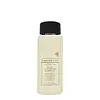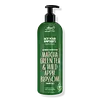What's inside
What's inside
 Key Ingredients
Key Ingredients

 Benefits
Benefits

 Concerns
Concerns

 Ingredients Side-by-side
Ingredients Side-by-side

Water
Skin ConditioningLauramidopropyl Betaine
CleansingCocamidopropyl Hydroxysultaine
CleansingSodium Cocoyl Isethionate
CleansingGlycerin
HumectantSodium Lauryl Sulfoacetate
CleansingDisodium Laureth Sulfosuccinate
CleansingAloe Barbadensis Leaf Juice
Skin ConditioningTocopheryl Acetate
AntioxidantCocos Nucifera Oil
MaskingPhenoxyethanol
PreservativeSodium Lauroyl Sarcosinate
CleansingSodium C14-16 Olefin Sulfonate
CleansingSoyamidopropylamine Oxide
CleansingPolyquaternium-71
HumectantMaltodextrin
AbsorbentSodium Cocoyl Glutamate
CleansingPanthenol
Skin ConditioningPolyquaternium-7
Sodium Hydroxide
BufferingCitric Acid
BufferingWater, Lauramidopropyl Betaine, Cocamidopropyl Hydroxysultaine, Sodium Cocoyl Isethionate, Glycerin, Sodium Lauryl Sulfoacetate, Disodium Laureth Sulfosuccinate, Aloe Barbadensis Leaf Juice, Tocopheryl Acetate, Cocos Nucifera Oil, Phenoxyethanol, Sodium Lauroyl Sarcosinate, Sodium C14-16 Olefin Sulfonate, Soyamidopropylamine Oxide, Polyquaternium-71, Maltodextrin, Sodium Cocoyl Glutamate, Panthenol, Polyquaternium-7, Sodium Hydroxide, Citric Acid
Water
Skin ConditioningSodium Lauroyl Sarcosinate
CleansingSodium Cocoyl Isethionate
CleansingCocamidopropyl Hydroxysultaine
CleansingCocamide Dipa
EmulsifyingPEG-120 Methyl Glucose Dioleate
EmulsifyingCamellia Sinensis Leaf Extract
AntimicrobialMalus Domestica Fruit Extract
AntioxidantLeuconostoc/Radish Root Ferment Filtrate
AntimicrobialPolyquaternium-10
Tetrasodium Glutamate Diacetate
Parfum
MaskingPhenoxyethanol
PreservativeEthylhexylglycerin
Skin ConditioningCitric Acid
BufferingWater, Sodium Lauroyl Sarcosinate, Sodium Cocoyl Isethionate, Cocamidopropyl Hydroxysultaine, Cocamide Dipa, PEG-120 Methyl Glucose Dioleate, Camellia Sinensis Leaf Extract, Malus Domestica Fruit Extract, Leuconostoc/Radish Root Ferment Filtrate, Polyquaternium-10, Tetrasodium Glutamate Diacetate, Parfum, Phenoxyethanol, Ethylhexylglycerin, Citric Acid
 Reviews
Reviews

Ingredients Explained
These ingredients are found in both products.
Ingredients higher up in an ingredient list are typically present in a larger amount.
Citric Acid is an alpha hydroxy acid (AHA) naturally found in citrus fruits like oranges, lemons, and limes.
Like other AHAs, citric acid can exfoliate skin by breaking down the bonds that hold dead skin cells together. This helps reveal smoother and brighter skin underneath.
However, this exfoliating effect only happens at high concentrations (20%) which can be hard to find in cosmetic products.
Due to this, citric acid is usually included in small amounts as a pH adjuster. This helps keep products slightly more acidic and compatible with skin's natural pH.
In skincare formulas, citric acid can:
While it can provide some skin benefits, research shows lactic acid and glycolic acid are generally more effective and less irritating exfoliants.
Most citric acid used in skincare today is made by fermenting sugars (usually from molasses). This synthetic version is identical to the natural citrus form but easier to stabilize and use in formulations.
Read more about some other popular AHA's here:
Learn more about Citric AcidCocamidopropyl Hydroxysultaine is a synthetic cleansing agent, though it is derived from coconut oil.
It is used to enhance the texture of products by boosting lather and thickening the texture. As a cleanser, Cocamidopropyl Hydroxysultaine is mild.
Phenoxyethanol is a preservative that has germicide, antimicrobial, and aromatic properties. Studies show that phenoxyethanol can prevent microbial growth. By itself, it has a scent that is similar to that of a rose.
It's often used in formulations along with Caprylyl Glycol to preserve the shelf life of products.
Sodium cocoyl isethionate is a natural ingredient from coconut oil. It is an ultra gentle cleanser that gives a nice foam without drying the skin or impacting the skin barrier.
The amount of foam created depends on the amount of sodium cocoyl isethionate used in the product.
This ingredient also helps improve the spreadability of a product.
Learn more about Sodium Cocoyl IsethionateSodium Lauroyl Sarcosinate is a cleansing agent and emulsifier. It is a surfactant derived from sarcosine, and a common source is coconut oil.
As a surfactant, Sodium Lauroyl Sarcosinate helps lift dirts, oil, and other molecules to be washed away. In leave-on products, this ingredient is used as an emulsifier. Emulsifier help prevent ingredients such as oils and waters from separating.
Sodium Lauroyl Sarcosinate is also commonly found as a foaming agent in shampoo, toothpaste, and shaving foam. It is amphiphilic, meaning it loves both water and fats.
Learn more about Sodium Lauroyl SarcosinateWater. It's the most common cosmetic ingredient of all. You'll usually see it at the top of ingredient lists, meaning that it makes up the largest part of the product.
So why is it so popular? Water most often acts as a solvent - this means that it helps dissolve other ingredients into the formulation.
You'll also recognize water as that liquid we all need to stay alive. If you see this, drink a glass of water. Stay hydrated!
Learn more about Water